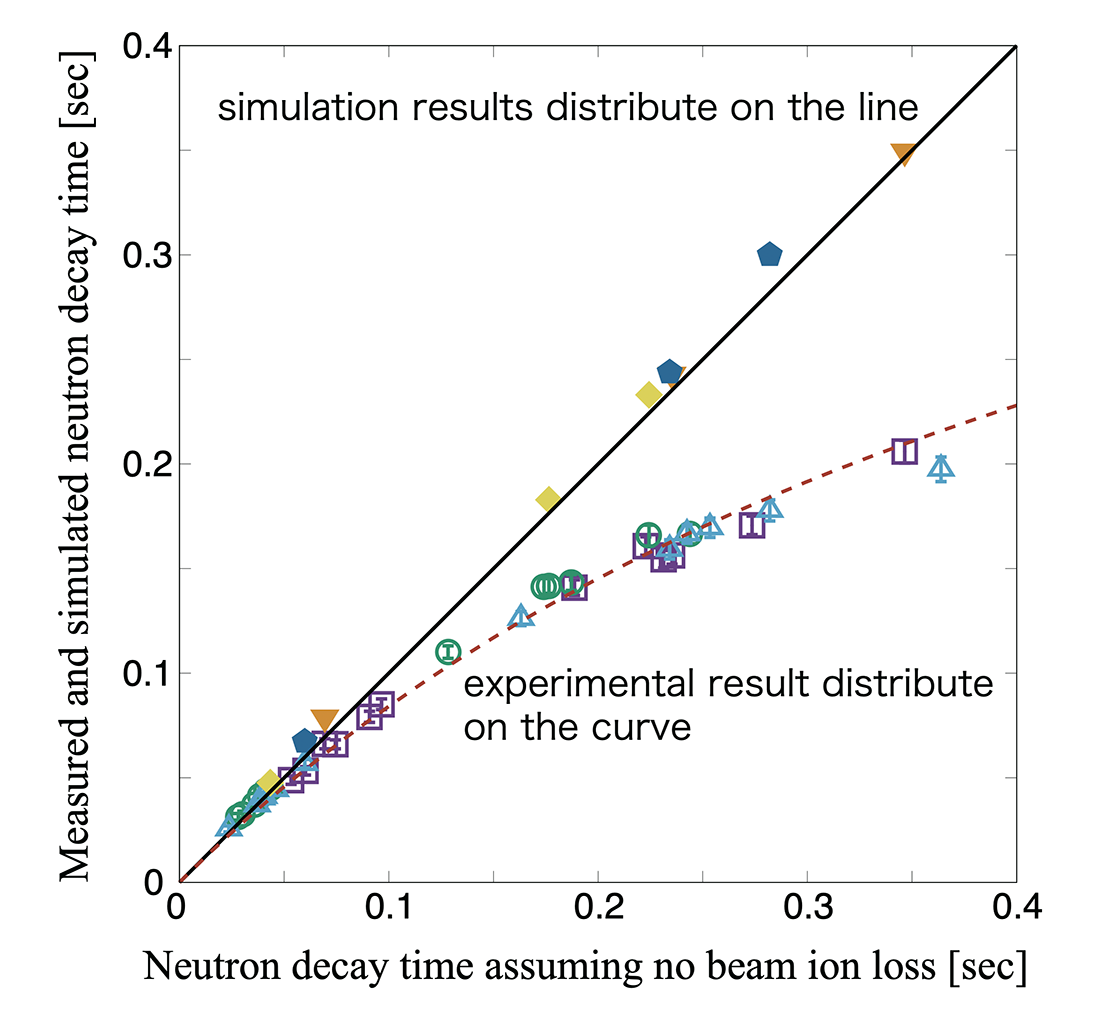Analysis of NB Beam-Ion Loss Mechanisms in LHD
The beam ion loss mechanism in LHD has been analyzed quantitatively by using the neutron measurement and the integrated simulation*. It has been known that the "neo-classical transport"** is dominant as the beam ion loss mechanism in large size tokamaks. Contrary to tokamak cases, the neo-classical simulation can not reproduce the experimental result in LHD. This result indicates that the other mechanism is dominant as the beam ion loss mechanism in LHD.

(Right) Comparison between the experimental results and the neo-classical simulation results. The horizontal axis indicates the neutron decay time assuming no beam ion loss and the vertical axis indicates the neutron decay time obtained by the experiment and the neo-classical simulation. The simulation results are distributed on the line, which has a unit gradient. This result means that the neo-classical transport is not the dominant mechanism of the beam ion loss.
The beam ion loss mechanism in the Large Helical Device (LHD) has been analyzed quantitatively by using neutron measurement and integrated simulation*. It has been known that the "neo-classical transport"** is dominant as the beam ion loss mechanism in large size tokamaks. Contrary to tokamak cases, the neo-classical simulation cannot reproduce experimental results in the LHD. This result indicates that the other mechanism is dominant as the beam ion loss mechanism in the LHD.
In our previous research "Estimation of the beam ion confinement time in LHD (June 17, 2020)", the confinement time of beam ions, which are injected by the neutral beam injection system, was estimated by using neutron measurement and integrated simulation. In the previous paper, however, the beam ion loss mechanism itself had remained unclear. In this paper, we have attempted to analyze the beam ion loss mechanism by using the integrated simulation.
In large-size tokamaks, such as JT-60U, it is well known that the beam ion loss can be explained by the neo-classical theory. Until this paper, a similar analysis had not been performed in large-size helical devices because this kind of experiment requires a deuterium experiment. Since neo-classical transport is significant in the helical devices rather than in tokamaks, we have performed simulations to clarify the contribution of the neo-classical transport to the beam ion loss at first.
As shown in the figure, it has been been found that the neo-classical simulation cannot reproduce experimental results. This finding indicates that the loss mechanism except the neo-classical transport is dominant in the LHD as opposed to large-size tokamaks. In this paper, we estimate the anomaly as the "charge exchange loss" by simple analysis. Because the charge exchange loss is sensitive to neutral particle density, which cannot be measured, further analysis is required to clarify the estimation.
This research result was published on April 21, 2021 in Plasma and Fusion Research, an online journal by the Japan Society of Plasma Science and Nuclear Fusion Research.
Publication
- H. Nuga et al., "Analysis of NB Fast-Ion Loss Mechanisms in MHD Quiescent LHD Plasmas", Plasma and Fusion Research 16 (2021) 2402052. [NIFS Repository]
Related references
Review article of the integrated simulation in fusion plasmas (JP)
http://www.jspf.or.jp/Journal/PDF_JSPF/jspf2019_09/jspf2019_09-423.pdf
Review article of the neo-classical transport (JP)
http://www.jspf.or.jp/Journal/PDF_JSPF/jspf2000_11/2000_11-1176.pdf
